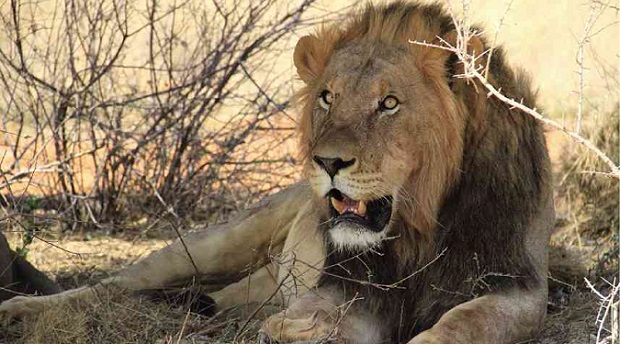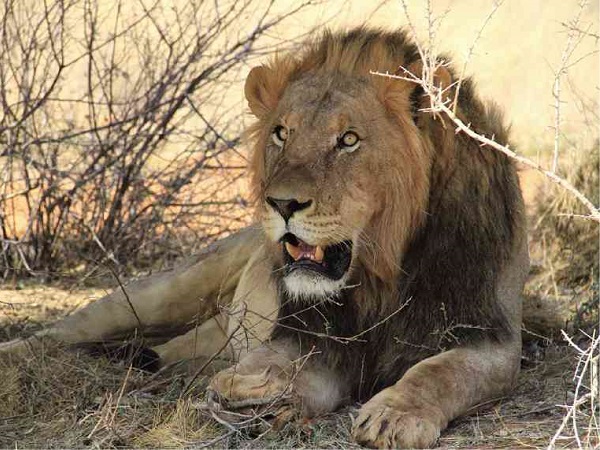
It had happened to me a few times before—gaping at majestic Mt. Mayon for the first time; seeing the crevasses of the Grand Canyon; taking in the expanse of the Great Wall as I rested on one of the steep climbs; and even after spotting St. Basil’s Cathedral in Moscow had it not been in subzero weather and my tears hadn’t iced over.

I cried in silence: Before me was the great king of the jungle, no cage or a glass partition between us, in its home in the wild.
It’s one of those things that you only imagine, and when you see it, right there before you, it engulfs you. That scene in “Jurassic Park” where they see the dinosaurs for the first time? Same feeling. It can convert a nonbeliever.
There were only a few meters, an innocuous armrest and our lanky tracker, Jacob, who had left his perilous perch in front of the truck to take the only vacant seat on my left, that separated me not from one but two African lions, in the heart of the Kalahari.
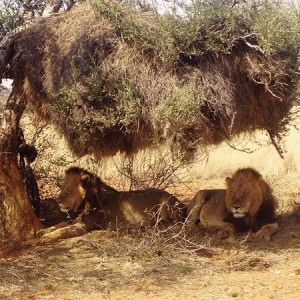
I had pictured coming this close to another mammal in the wild, perhaps a friendly giraffe, maybe even a meerkat, but never one of Africa’s so-called “big five,” and one of the most ferocious and most feared beasts there are.
Debauchery
And yet there they were, these two big cats, on their midday siesta in the bush underneath a shady nest of Social Weavers, looking unperturbed and seemingly bored by our presence. Was that a yawn?
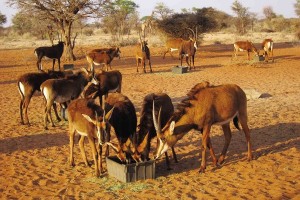
Our guide and private ranger, Travis, warned us against making sudden moves or noises; the lions took the entire truck as one unit, which was bigger than both of them combined, so they would ignore us as long as we respected their space.
At one point, one hugged and buried its face on a tree trunk, as if in remorse for their recent debauchery. Travis pointed out the dried bloodstains on their large paws; the beasts had a big dinner of kudu, an antelope species, the previous night.
A little farther out, we would find the adult lionesses and their cubs, also taking respite from the midday sun under the bushes, their dusty coats blending easily into the background of dried grass and ochre soil. Just like the males, they hardly paid us attention.
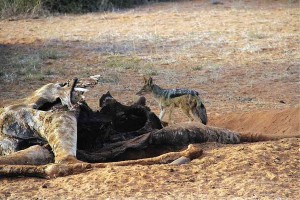
The adult males, according to Travis, are brothers from the same litter and the true kings of Tswalu Kalahari, the country’s largest luxury game reserve at 100,000 hectares.
Home to Africa’s big five—lion, rhinoceros, leopard, African elephant and Cape buffalo—Tswalu is in an enviable location as it’s in the southern Kalahari, which receives more rain than the harsher and more arid central desert region in Botswana and Namibia. It’s often referred to as the Green Kalahari.

It was only our second day in Northern Cape, South Africa’s largest and most sparsely populated province, and already we had seen and experienced things we never dreamed of doing even in an African safari.
Rhinoceros
Our skilled and relentless ranger and tracker made sure our game drive—or what most of us refer to as “safari”—was rewarding. The lions were just a teaser.
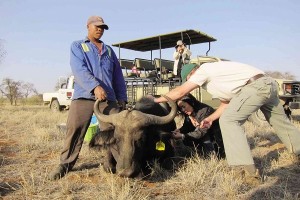
After three to four hours on the bumpy terrain, our group of five Filipinos and four Northern Cape hosts came within sight of a black rhinoceros and her young, a species so critically endangered it’s both a blessing and a burden to see them in this lifetime. (Rhinos are notoriously skittish; when startled, they either flee or charge, we had to stay at a far greater distance than we did with the lions.)
The rhinos are hunted for their horn, believed in some Asian countries as a cure for cancer, making them highly prized and coveted by poachers.
The rhino population has dwindled dramatically in the last century due to hunting, and it’s believed that there are only less than 5,000 black rhinos left in the wild today.

De Beers
At Tswalu (www.tswalu.com), where wildlife conservation is the thrust, Travis declined to say the exact number of their rhinos so as not to attract poachers, merely saying they had a “healthy” population.
Unlike reserves with breeding programs, they don’t interfere with the animals at Tswalu. The beasts hunt for their own food. If they fall ill or get frostbite, they’re on their own, Travis said. Nature takes its course.

As beautiful as the beasts are, being in the wilderness also lets you in on the harsh realities of the jungle. By the road was a rotting, two-week-old carcass of a giraffe, the lions’ leftovers, its putrid smell perhaps so alluring to the duo of scavenging jackals feasting on it as we passed.
The Oppenheimer family, longtime owners of the De Beers diamond company until last year, also own Tswalu, and the hospitality component of the property is run primarily to help finance their wildlife conservation efforts.
We stayed at Tarkuni, the Oppenheimers’ private home with five plush suites. It accommodates up to 10 people and costs about 50,000 South African rand (1 rand= P4.30) a night.
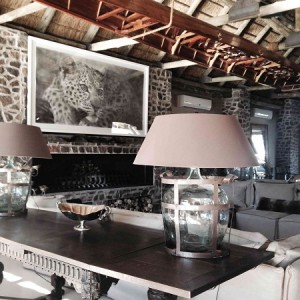
It comes with a private chef, a swimming pool, house staff, a game-viewing truck and your own guide and tracker.
Rock star
Also in the property is The Motse, eight separate legaes or suites, where actress Drew Barrymore and her husband stayed a week before our arrival. It was in Tswalu where Louis Vuitton shot Bono and his wife for an ad campaign.
It’s a place worthy of a rock star.
Incidentally, it was National Braai Day on our evening at Tarkuni, and our chef prepared exotic meats including kudu and karoo lamb for the traditional barbecue celebration at a boma or an outdoor enclosure.
Before flying out to Tswalu, we spent our first night in Northern Cape at the Mattanu Private Game Reserve (www.mattanu.com), just outside Kimberley, the provincial capital. Unlike Tswalu, Mattanu has a breeding program, and we participated in a “game capture.”
Buffalos
Dr. Johann Kriek, the veterinarian owner-founder, and his pilot son flew on their helicopter and immobilized two buffalos with a dart. Buffalos can be dangerous, so sedating them from above is necessary to ensure they don’t attack people on the ground during a capture. So, yes, you can grab a bull by its horn—which I did—but only if it’s tranquilized.
This is a regular activity meant to check the animals for diseases and monitor their growth. Our touring group helped inject the beasts with vaccines, as well as spray antitick medicines on their behinds.
Doctor Kriek is a pioneer in breeding disease-free Cape buffalos, and he has also led the breeding program for the Roan antelope, a rare and the second largest of the species, which is endemic to the country.
It was early spring on our visit, and being a breeding reserve, we also watched them feed the antelopes. It’s the kind of thing you’ll never see in a place like Tswalu. The Krieks sell Roan antelopes to other reserves.
Starlit sky
At Mattanu, we viewed the wild game from the helicopter, before we were flown into the bush for dinner (prepared by the Kriek matriarch) under the starlit African sky. With the sound of crushed leaves under hooves and the distant cry of a beast in the background, it’s a disconcerting experience at first, but the locals assure you: The animals are more afraid of you than you are of them. The night before, a guest proposed to his girlfriend at a dinner here.
But even more alarming, I have to admit, was the accommodation at first glance: tents elevated on a concrete platform, with no fences to ward off the beasts!
I learned soon enough, however, that my fears were unfounded. Save for a bullfrog that croaked like a cat in heat all night, I was cocooned in secure luxury in my tent, which had all the modern amenities as designed by Doctor Kriek’s other son, Jacques, the general manager.
Close to nature but with all the creature comforts: en suite Jacuzzi bath, air conditioning and heating, as well as a plush bed and my own little veranda.
It was in Mattanu that we learned to match the names to the animals called springbok, kudu, oryx, sable antelope, impala, wildebeest, hartebeest.
It was also there that we first saw a warthog, and came to meet a curious pack of giraffes.
Practically all the beasts scamper off when they hear a truck coming, with only the lions and giraffes as exemption. Poised with their long, elegant necks, giraffes stop in their tracks and stare at the humans, unperturbed and unthreatened. It’s pure pleasure to see their mottled forms and little horns hovering over trees as you go on a game drive.
Leopard
It was a different safari experience altogether at Augrabies, a small town by the Orange River, near the city of Upington. Here we came across the dassie, a rodent-like creature that’s a closer relative of the elephant, and a leopard—or at least a proof that there’s a leopard in the area: its feces. (We had no luck finding this big cat on all the game drives. Our experienced guides at Tutwa Desert Lodge had never seen one. Leopards are also threatened with extinction.)
What was unique with our Tutwa experience was that we learned fly-fishing in the Orange River, and also went canoeing and river rafting. Our guide Craig even gamely gave in to our request to set foot—or more like set hand—in Namibia, which was just across the river.
Luxury safari
Tutwa Desert Lodge (www.tutwalodge.co.za) was just as luxurious as Tswalu and Mattanu, the perfect retreat from the rugged outdoors. The décor was safari chic; and the lodge had seven deluxe rooms and two suites, a swimming pool and a fully stocked bar. Service and meals were excellent, the property efficiently run by Craig’s wife Charmaine.
A luxury Northern Cape safari is an experience of total indulgence. You’re flown around in private little planes. You get up at daybreak for some coffee or tea with rusk, a hard and dry biscuit, before setting off for a morning game drive. Then you return for breakfast at about 9 a.m. There’s lunch, and in-between is spent at leisure.
By 4 p.m., you set off again for another game drive. This may sound repetitious, but you never see the same animals on every game drive. Even after five, seven days of these, they never get old; each one is a new experience.
Hot-air ballooning
But meeting wild beasts is not all that you will experience in Northern Cape. Think hot-air ballooning over the Kalahari Desert, for instance, and even wine tasting at the numerous vineyards and wineries.
Of course, how could you leave the diamond-mining city of Kimberley without at least a fraction of a carat of the precious gem? But the details, I’ll have to save for another story.
Our media familiarization tour was sponsored by the Embassy of the Republic of South Africa and the Department of Economic Development and Tourism of the Northern Cape, with airline partner Thai Airways.
Thai Airways has a special all-in promotional fare to Johannesburg until today, Nov. 30. It departs from Manila every Wednesday, Thursday, Friday and Sunday at 8:30 p.m., and arrives in Bangkok in time for the connecting flights to Johannesburg. Visit www. thaiairways.com or call reservations at 5808424,
e-mail [email protected], or e-mail Thai Airways’ district sales manager Malu Dueñas at [email protected]. Northern Cape’s capital Kimberley is a
1½-hour flight from Johannesburg.
Visit www.experiencenortherncape.com. For personalized itineraries, send an e-mail to Tata Ma Tata Tours owner Ed Smith, our guide in Northern Cape, at [email protected] or visit www.tatamatata.co.za.

